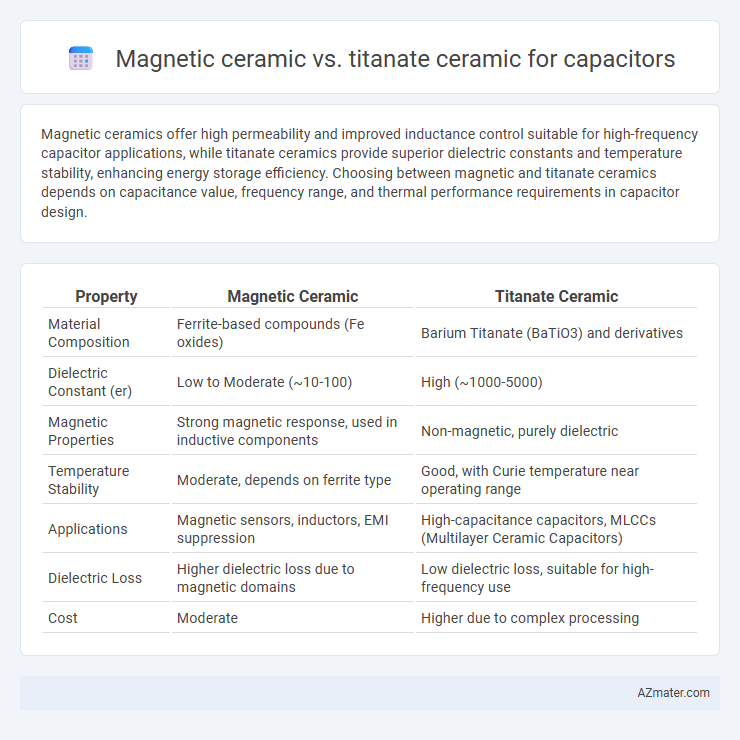Magnetic ceramics offer high permeability and improved inductance control suitable for high-frequency capacitor applications, while titanate ceramics provide superior dielectric constants and temperature stability, enhancing energy storage efficiency. Choosing between magnetic and titanate ceramics depends on capacitance value, frequency range, and thermal performance requirements in capacitor design.
Table of Comparison
| Property | Magnetic Ceramic | Titanate Ceramic |
|---|---|---|
| Material Composition | Ferrite-based compounds (Fe oxides) | Barium Titanate (BaTiO3) and derivatives |
| Dielectric Constant (er) | Low to Moderate (~10-100) | High (~1000-5000) |
| Magnetic Properties | Strong magnetic response, used in inductive components | Non-magnetic, purely dielectric |
| Temperature Stability | Moderate, depends on ferrite type | Good, with Curie temperature near operating range |
| Applications | Magnetic sensors, inductors, EMI suppression | High-capacitance capacitors, MLCCs (Multilayer Ceramic Capacitors) |
| Dielectric Loss | Higher dielectric loss due to magnetic domains | Low dielectric loss, suitable for high-frequency use |
| Cost | Moderate | Higher due to complex processing |
Introduction to Ceramic Capacitors
Ceramic capacitors utilize dielectric materials like magnetic ceramic and titanate ceramic to store electrical energy efficiently. Magnetic ceramic capacitors offer high magnetic permeability and stability, making them suitable for high-frequency applications, while titanate ceramic capacitors provide a higher dielectric constant and improved temperature stability, ideal for precision electronic circuits. Selecting between magnetic and titanate ceramics depends on the required capacitance range, frequency response, and thermal performance in electronic devices.
Overview of Magnetic Ceramics
Magnetic ceramics, such as ferrites, exhibit high magnetic permeability and low electrical conductivity, making them essential for inductive components and electromagnetic applications. Unlike titanate ceramics primarily used for dielectric properties in capacitors, magnetic ceramics enable efficient energy storage in magnetic fields and enhanced high-frequency performance. Their unique microstructure and magnetic domain configuration contribute to superior magnetic loss characteristics and thermal stability crucial for advanced electronic devices.
Understanding Titanate Ceramics
Titanate ceramics, primarily composed of barium titanate (BaTiO3), exhibit high dielectric constants and excellent temperature stability, making them ideal for multilayer ceramic capacitors (MLCCs). Compared to magnetic ceramics, titanate ceramics offer superior capacitance density and lower dielectric loss, enhancing performance in high-frequency and precision applications. Their unique ferroelectric properties enable tunable permittivity, crucial for capacitors used in automotive, telecommunications, and consumer electronics industries.
Material Properties Comparison
Magnetic ceramics exhibit high magnetic permeability and low dielectric losses, making them suitable for inductive components, while titanate ceramics, such as barium titanate, offer high dielectric constants and excellent temperature stability ideal for capacitors. The grain structure of titanate ceramics enhances their capacitance by enabling strong polarization under an electric field, whereas magnetic ceramics prioritize magnetic flux control. Thermal conductivity is generally higher in magnetic ceramics, but titanate ceramics excel in dielectric breakdown strength, ensuring reliable capacitor performance.
Dielectric Properties and Performance
Magnetic ceramics typically exhibit moderate dielectric constants and high permeability, making them suitable for applications requiring magnetic responsiveness with stable dielectric properties. Titanate ceramics, such as Barium Titanate, possess exceptionally high dielectric constants and low dielectric losses, resulting in superior energy storage capacity and enhanced capacitor performance. The choice between magnetic and titanate ceramics hinges on the required balance between magnetic behavior and dielectric efficiency for specific capacitor applications.
Frequency Response Analysis
Magnetic ceramics, typically ferrite-based, exhibit superior frequency response characteristics in high-frequency capacitor applications due to their low magnetic losses and stable permeability. In contrast, titanate ceramics offer high dielectric constants but suffer from increased dielectric losses and limited frequency stability beyond the megahertz range. Frequency response analysis reveals that magnetic ceramic capacitors maintain consistent impedance and quality factor (Q) across a wider frequency spectrum, making them ideal for RF and microwave circuits.
Applications in Modern Electronics
Magnetic ceramics, known for their high permeability and magnetic loss properties, are ideal for inductors and transformers in high-frequency applications, enabling efficient energy storage and signal filtering in modern communication devices. Titanate ceramics, such as barium titanate, exhibit excellent dielectric properties and high permittivity, making them essential for multilayer ceramic capacitors (MLCCs) used in smartphones, automotive electronics, and IoT devices. The distinct electrical and magnetic characteristics of magnetic and titanate ceramics drive their targeted use in modern electronics to enhance performance, miniaturization, and reliability of components.
Advantages and Limitations of Magnetic Ceramics
Magnetic ceramics in capacitors offer superior permeability and improved energy storage capabilities compared to titanate ceramics, making them ideal for high-frequency applications and miniaturized devices. They exhibit excellent thermal stability and low dielectric loss, but face limitations such as lower dielectric constant and potential magnetic hysteresis, which can affect efficiency in certain circuits. While titanate ceramics provide higher dielectric constants and better voltage handling, magnetic ceramics excel in noise reduction and frequency response, benefiting specific electronic components.
Benefits and Drawbacks of Titanate Ceramics
Titanate ceramics in capacitors offer high dielectric constants, resulting in greater capacitance per volume, which makes them ideal for miniaturized electronic components. However, they exhibit temperature instability and higher dielectric losses compared to magnetic ceramics, potentially reducing reliability in high-frequency or high-temperature applications. Their sensitivity to environmental factors requires careful circuit design to maintain performance consistency in demanding conditions.
Choosing the Right Ceramic for Your Capacitor Needs
Magnetic ceramics offer high permeability and enhanced inductive properties suitable for specialized applications requiring magnetic field interaction, while titanate ceramics provide stable dielectric constants and low losses ideal for high-frequency and high-capacitance capacitors. Choosing the right ceramic type depends on the required dielectric constant, temperature stability, and operating frequency range, with titanate ceramics preferred for energy storage and magnetic ceramics for inductive components. Evaluating specific application requirements ensures optimal capacitor performance, balancing permittivity, dissipation factor, and thermal stability.

Infographic: Magnetic ceramic vs Titanate ceramic for Capacitor
 azmater.com
azmater.com